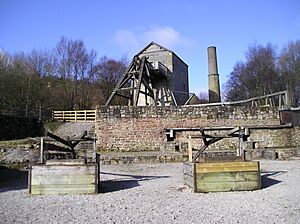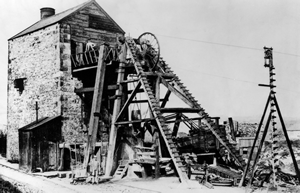Minera Lead Mines facts for kids
Minera, a small place near Wrexham in North-East Wales, was once a very important spot for mining lead. For hundreds of years, people dug deep into the ground here to find valuable metals. The mines were busiest in the 1860s. Mining stopped completely in 1914.
Today, the area has been transformed into a fun place to visit called the Minera Lead Mines and Country Park. You can explore the old mining equipment and enjoy nature where the spoil tips (piles of leftover rock) have been turned into green spaces.
Contents
A Look Back: The History of Minera Mines
Early Days of Mining Lead
People might have started mining lead in Minera as far back as the Roman Empire! However, we don't have any solid proof from that time. The first time we see Minera mining mentioned in writing was in 1296. Edward I of England, a king, hired miners from Minera to work in his new mines in another part of England.
Mining continued in Minera until 1349. This was when a terrible sickness called the Black Death spread across Europe, causing many mines to close. We don't know exactly when mining started again after that.
Dealing with Water: A Big Challenge
One of the biggest problems for miners was water. As they dug deeper, the mines would fill with water. To solve this, they created tunnels called adits to drain the water away. Later, in the late 1700s, they started using powerful steam engines to pump the water out.
Different Mining Areas
The Minera area had many lead veins, which are like underground rivers of metal. Over 100 mine shafts were dug, and many different companies tried their luck. We can think of the mining area in three main parts:
- The Eisteddfod Mines: These were to the north of the Minera Limestone Quarry.
- The Mountain Mines: Found on Minera Mountain, south of the quarry.
- The "Old Minera Mines": Located on the west side of the Clywedog river valley.
The Eisteddfod mines might be where mining first began. There's evidence of shallow digging there, along with later, deeper mines. Many companies came and went, often merging with each other. The last of these, the Hush Eisteddfod Lead Mining company, stopped working in 1886. This marked the end of mining in the Eisteddfod area.
The Mountain mines were active from the 1820s. Like the Eisteddfod area, many companies operated here. The Minera Mountain Lead Mining Company was formed in 1885 but closed down in 1891. After that, attempts to restart mining there didn't work out.
The "Old Minera Mines" and New Beginnings
The "Old Minera Mines" were worked from 1720 to 1824. They closed because of the constant problem of water. John Wilkinson, a famous iron maker, was involved in one of these mines. He installed a steam pumping engine in 1784 to help with the water. Even with more engines, the cost of pumping water became too high, and these mines closed.
Mining started again in this area in 1848. A big international company called John Taylor & Sons formed the Minera Mining Company. They invested a lot of money to improve things. They built a long drainage tunnel and installed new, powerful steam engines. One huge engine had an 80-inch cylinder and was made by Harvey's of Hayle. They also built a railway line to help transport materials.
With the water under control, they found lots of new lead ore! The Minera Lead Mines Country Park is near Meadow's shaft, which was about 300 to 400 meters deep. By 1870, there were 14 shafts along the railway line.
The End of an Era
John Taylor & Sons invested £30,000 by 1851 to get the mines running again. By 1864, they were making huge profits, around £60,000 (which would be over £4 million today!).
However, things changed. By 1900, the price of lead and zinc dropped a lot. At the same time, the price of coal (which powered the steam engines) went up. In 1908, the United Minera Mining Company announced that the mines were no longer making enough money. They decided to turn off the pumps, which meant the mines would slowly fill with water over the next two years. All the mining equipment was sold by 1914, and the mines closed for good.
Getting Around: Transporting Lead and Coal
The Minera Railway Line
To move the lead ore and bring in coal, the Minera Mining Company built its own railway line. It was finished by 1851 and connected to another railway line at Minera Limeworks. The mines even had their own steam locomotive, a train named Henrietta, to pull the wagons. Lead ore went to Wrexham to be sent across the country, and coal came back to power the mine engines.
When the mines closed in 1914, the railway tracks were removed. But they were put back in 1932 to serve two quarries that dug for silica clay. The railway line was finally removed for good in 1962.
Future Plans for a Tourist Railway
In the 1990s, there were plans to build a special narrow gauge railway for tourists on the old trackbed, running from the lead mines towards the Minera Limeworks. However, these plans never happened.
The Minera Quarry, which was still active then, closed in 1994. Today, the quarry is owned by the North Wales Wildlife Trust and was opened to the public in June 2018.
Bringing it Back to Life: Restoration of the Mines
Making the Area Safe and Fun
Starting in 1988, a lot of work was done to clean up and restore the Minera mining area. This project was funded by Wrexham County Borough Council and the Welsh Development Agency. The main goal was to make sure that the leftover spoil (piles of rock and waste) from lead, zinc, and lime mining didn't pollute local water.
A second phase of restoration began in 1990, focusing on the Meadow's engine house. The engine house was rebuilt, and new replica machinery was put inside, since the original steam engine was removed in 1914.
Today, there's a visitor centre, and you can take a tour of the engine house. It's a popular place for tourists in Wrexham.
Recent Changes
In 2004, vandals damaged the site, but the council repaired it in 2005. By 2024, some of the large wooden parts that supported the winding gear (machinery used to lift things from the mine) had become old and unsafe. So, these parts were removed to keep visitors safe.




